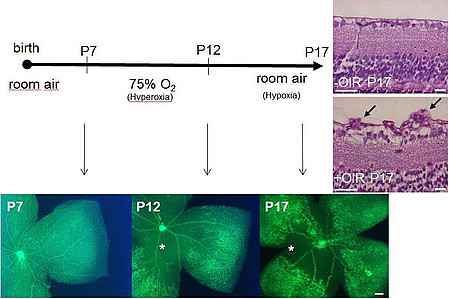Sie befinden sich hier
Inhalt
Diabetic retinopathy is characterized by the breakdown of the neurovascular unit, leading to vasoregression due to the loss of pericytes and endothelial cells. Pericyte loss is the earliest vascular morphological change in non-proliferative diabetic retinopathy. Proliferative diabetic retinopathy occurs through retinal angiogenesis when new blood vessels grow from the damaged vasculature. The newly formed blood vessels are leaky, bleed easily and thus obscure vision.
The aim of our research group is to study the mechanisms underlying the development of diabetic retinopathy and proliferative diabetic retinopathy and provide novel intervention strategies for this disease.
We use
- in vivo: different transgenic mouse models for physiological retinal angiogenesis; hypoxia-induced proliferative retinopathy; streptozotozin - and high fat-induced diabetic retinopathy
- in vitro: primary vascular cells and retinal glia cells with gene manipulation by transfection with gene-specific siRNA or transduced with viruses for gene overexpression
Numerous angiogenic factors are essential in the physiological and pathological retina, as well as proliferative diabetic retinopathy. Our previous study revealed that Angiopoetin-2 (Ang2) plays a substantial role in diabetic retinopathy, in both proliferative and non-proliferative stages. We use different animal models mimicking diabetic retinopathy as well as cultured cells mimicking diabetic cellular damages, to understand the signaling pathways involved in Ang2 regulation during glucose metabolism and angiogenic response of the retinal neurovascular unit.
Our current main focuses are:
- Signal transduction through Nucleoside Diphosphate Kinase B in angiogenesis and glucose metabolism
- Interaction of glucose and nucleotide metabolism and its role during Ang2 regulation in diabetes.
- Signaling involved in protein GlcNAcylation and the Tie2-FOXO1-Ang2 cascade
- Caveolin1-mediated membrane trafficking in Tie2-FOXO1-Ang2 signaling
- Neurovascular unit as a therapeutic target in diabetic retinopathy.
Publications
- Abu-Taha IH, Heijman J, Feng Y, Vettel C, Dobrev D, Wieland T. Regulation of heterotrimeric G-protein signaling by NDPK/NME proteins and caveolins: an update. Lab Invest. 2018 Feb;98(2):190-197.
- Garg J, Feng YX, Jansen SR, Friedrich J, Lezoualc'h F, Schmidt M, Wieland T. Catecholamines facilitate VEGF-dependent angiogenesis via β2-adrenoceptor-induced Epac1 and PKA activation. Oncotarget. 2017 Jul 4;8(27):44732-44748.
- Gross S, Devraj K, Feng Y, Macas J, Liebner S, Wieland T. Nucleoside diphosphate kinase B regulates angiogenic responses in the endothelium via caveolae formation and c-Src-mediated caveolin-1 phosphorylation. J Cereb Blood Flow Metab. 2017 Jul;37(7):2471-2484.
- Qiu Y, Zhao D, Butenschön VM, Bauer AT, Schneider SW, Skolnik EY, Hammes HP, Wieland T, Feng Y. Nucleoside diphosphate kinase B deficiency causes a diabetes-like vascular pathology via up-regulation of endothelial angiopoietin-2 in the retina. Acta Diabetol. 2016 Feb;53(1):81-9.
- Feng Y, Gross S, Chatterjee A, Wang Y, Lin J, Hammes HP. Transcription of Inflammatory Cytokine TNFα is Upregulated in Retinal Angiogenesis under Hyperoxia. Cell Physiol Biochem. 39(2):573-83, 2016
- Feng Y, Gross S, Wolf NM, Butenschön VM, Qiu Y, Devraj K, Liebner S, Kroll J, Skolnik EY, Hammes HP, Wieland T. Nucleoside diphosphate kinase B regulates angiogenesis through modulation of vascular endothelial growth factor receptor type 2 and endothelial adherens junction proteins. Arterioscler Thromb Vasc Biol. 2014 Oct;34(10):2292-300.
- Feng Y, Wang Y, Yang Z, Wu L, Hoffmann S, Wieland T, Gretz N, Hammes HP. Chronic hyperglycemia inhibits vasoregression in a transgenic model of retinal degeneration. Acta Diabetol, 51(2):211-8, 2014
- Feng Y, Busch S, Gretz N, Hoffmann S, Hammes HP. Crosstalk in the retinal neurovascular unit - lessons for the diabetic retina. Exp Clin Endocrinol Diabetes, 120(4):199-201, 2012
Kontextspalte
Group Leader

PD Dr. Yuxi Feng
Phone +49 621 383-71762
yuxi.feng@medma.uni-heidelberg.de


